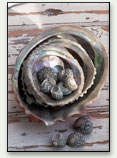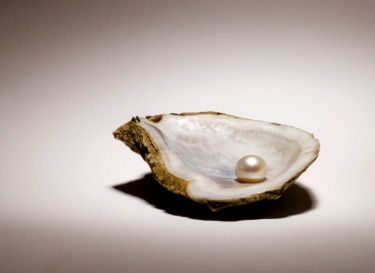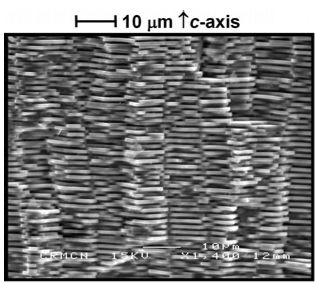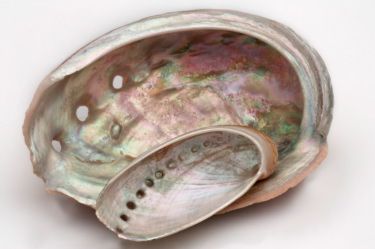A page from the "Causes of Color" exhibit...
Why are pearls and seashells iridescent?

We never seem to outgrow the urge to pick up an abalone shell and twist it in the light, marveling at its ever-changing iridescence.
The wings of the blue Morpho butterfly and the surface of the mother-of-pearl seashell share a beautiful mode of coloration: iridescence. The cause of this phenomenon has been attributed variously to diffraction, a combination of diffraction and interference, and interference alone.
What are pearls and mother-of-pearl?
Pearls are greatly valued in the jewelry industry, and are classified as organic gems because living creatures create them. The life of a pearl starts when a particle or piece of grit ends up in a shell of a marine or freshwater mollusk like an oyster or clam (either naturally or placed there by a person). As a defense mechanism, the particle is then coated with layers of nacre, a blend of minerals secreted by the oysters or other mollusks. These layers eventually become a thick enough coating to form a pearl.
Mother-of-pearl is the name commonly given to shells coated in a deposit of nacre. This nacre is secreted by oysters and other mollusks and is deposited on the inside of their shells to protect their bodies from parasites and foreign objects. To us, the shells appear iridescent.
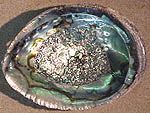
Mother-of-pearl is the name commonly given to shells coated in a deposit of nacre, which is iridescent. |
A pearl is formed when a mollusk coats a particle or piece of grit with layers of nacre. |
Scanning electron image of Trochus niloticus, fractured. In cross-section, a pearl will appear to have concentric, smooth layers, but magnification shows these layers have a brick wall-like structure. An organic glue holds these tiny plates together.
What is nacre?
Pearls and mother-of-pearl are both made from nacre, an organic-inorganic nanocomposite material. It is strong, resilient, and iridescent, and it has high fracture-resistance. Nacre is secreted by some mollusks, including pearl oyster shells and freshwater pearl mussels. It is composed of plates of calcium carbonate (CaCO3), which can range from 300 to 1500 nm thick, and an organic material that appears to act as a glue.
For years, scientists believed that the strength and resilience of nacre stemmed from layers of calcium carbonate crystallized over preformed layers of chitin (a common scaffolding material found in many insect shells). Studies with scanning electron microscopes suggest that, rather than being laid down in sheets, the calcium carbonate is laid down in a brick-like structure scattered through an organic matrix. The presence of chitin is disputed, and many believe that the organic material is conchiolin. Because of its unusual properties, especially its extremely high fracture-resistance, the composition of this material is still being studied.
Schematic illustration of the structure of nacre showing the different components. Nacre appears to be made up of “bricks” and these “bricks” are made up of nanoscale asperities.
Using incident laser light, researchers recently proved that an abalone shell surface has a reflection diffraction grating structure.
Why is nacre iridescent?
Nacre is iridescent because the thickness of the calcium carbonate layer is similar to the wavelength of light. Light reflected from the outer surface is therefore able to interfere with light reflected from the inner surface. Constructive and destructive interference of different wavelengths of light produces different colors when viewed at different angles of incident light.
Recently, research has demonstrated that diffraction plays a major role in creating iridescent color effects in mollusk shells. By using a scanning electron microscope (SEM), the surface of a French Polynesian abalone shell was found to have a fine-scale diffraction grating structure. In addition, stacks of thin crystalline nacreous layers or platelets were found below the surface. These observations suggest that the iridescent colors are caused by both diffraction and interference. The strong iridescent colors of the shell are the result of high groove density on the surface, which causes diffraction. The uniform stacking of layers of nacre below the surface of the shell also causes interference effects that contribute to the iridescent colors.
The pearl derives its iridescence from the diffraction and interference of white light, caused by tiny overlapping platelets of calcium carbonate. The iridescence or orient of the pearl is a function of the numbers and thickness of these platelets.




